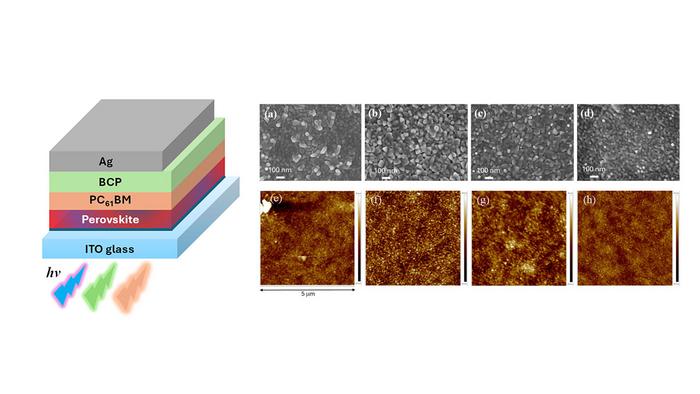
In the rapidly evolving landscape of renewable energy technologies, perovskite solar cells (PeSCs) have emerged as a groundbreaking innovation, poised to revolutionize the way we harvest and utilize solar power. Unlike conventional silicon-based solar panels, which are typically bulky, rigid, and optimized for strong outdoor sunlight, these next-generation perovskite devices exhibit remarkable adaptability, particularly in indoor environments illuminated by artificial lighting. Recent research led by a team at National Yang Ming Chiao Tung University in Taiwan delves deeply into the unique properties of PeSCs, demonstrating their unprecedented efficiency in converting indoor fluorescent light into electrical energy, thereby opening new frontiers for solar technology applications.
Traditional silicon solar cells have dominated the market for decades due to their relative efficiency under direct sunlight. However, their physical characteristics impose significant constraints, as they are heavy, inflexible, and largely limited to flat surfaces exposed to natural light. By contrast, perovskite solar cells are composed of a crystalline structure that allows for thin, lightweight, flexible, and even semi-transparent designs. This flexibility does not only imply physical form factor advantages but also enables diverse deployment scenarios such as integration with wearable electronics, smart home devices, and low-light indoor environments, creating new opportunities for the implanting of solar harvesting technologies within everyday items.
One of the critical breakthroughs presented in this study involves the strategic tuning of the bandgap of perovskite materials. The bandgap refers to the minimum energy required for electrons to transition from a lower energy state to a higher one, effectively determining the spectrum of light that a material can absorb and convert into electrical energy. By precisely adjusting the chemical composition of the perovskite, researchers optimized this bandgap to better capture the lower intensity, longer wavelength light emitted by artificial indoor sources such as fluorescent and LED lighting. This level of tailored spectral absorption is a significant advantage over silicon cells, which have fixed bandgap properties and therefore lack efficiency in suboptimal lighting conditions.
.adsslot_VJBu0DQUae{width:728px !important;height:90px !important;}
@media(max-width:1199px){ .adsslot_VJBu0DQUae{width:468px !important;height:60px !important;}
}
@media(max-width:767px){ .adsslot_VJBu0DQUae{width:320px !important;height:50px !important;}
}
ADVERTISEMENT
Bandgap engineering in wide-bandgap perovskite solar cells, however, introduces complexities related to the introduction of crystal defects within the perovskite layers. These imperfections can trap charge carriers, limiting the efficiency and stability of the solar cells. To address this challenge, the research team employed a chelating agent-based defect passivation technique. Chelating agents effectively bind to and neutralize defect sites, mitigating their detrimental electrical effects and reducing recombination losses. This defect passivation strategy not only enhances the photovoltaic performance but also significantly improves the environmental stability and longevity of the PeSCs, overcoming one of the foremost hurdles in the commercialization of perovskite solar technology.
Performance testing under various illuminance levels revealed striking results. Under a standard simulated sunlight intensity of approximately 12,000 lux, these optimized perovskite devices reached a power conversion efficiency (PCE) of 12.7%. Though this value trails behind high-efficiency silicon cells that can achieve about 26% under similar illumination, the difference becomes negligible when comparing performance under typical indoor lighting levels. Remarkably, under 2,000 lux illumination—akin to standard office lighting—the PeSCs achieved an extraordinary PCE of 38.7%. This elevated efficiency under dimmer light highlights the unique proficiency of perovskite cells in harvesting energy from environments traditionally considered suboptimal for solar technology.
The implications of such highly efficient indoor photovoltaic devices are vast and multifaceted. Imagine intelligent building materials that power sensors embedded in smart homes, eliminating the need for wired connections or frequent battery replacements. Similarly, wearable technology and Internet of Things (IoT) devices, which often suffer from limited battery life, could be sustained autonomously through ambient indoor lighting. These advancements point toward a future where solar harvesting ceases to be reliant on direct sunlight exposure and instead becomes a ubiquitous, integrated feature of everyday electronics and infrastructure.
In the realm of device engineering, the flexibility and lightweight nature of PeSCs permit seamless integration in unconventional settings. Semi-transparent perovskite films could function as energy-generating windows or displays, turning architectural elements into power sources without compromising aesthetics or functionality. Moreover, the thin-film fabrication techniques used for these materials are inherently compatible with scalable manufacturing processes, potentially allowing mass production at lower costs compared to crystalline silicon solar panels.
While earlier reports emphasized the high efficiency of perovskites under outdoor conditions, this research underscores the paramount importance of indoor-specific optimization, especially given the global trend toward increased automation and sensor networks inside commercial and residential buildings. It also signifies an important step in addressing the power demands of low-energy electronics, which currently rely heavily on disposable or rechargeable batteries constrained by capacity and environmental concerns.
Additionally, this study contributes a novel approach to enhancing device stability, often regarded as a bottleneck for perovskite commercialization. The chelating agent-based passivation not only remedies defect-induced efficiency losses but also confers enhanced resistance against environmental degradation—such as moisture and oxygen ingress—that typically plague perovskite films. Improving the durability of perovskite solar cells is critical to their real-world application, particularly indoors where devices must maintain reliable function over extended periods without frequent maintenance or replacement.
The team’s findings represent a significant advancement in perovskite technology, reinforcing the material’s versatility and functional superiority in indoor energy harvesting. The synergy between bandgap tuning and defect passivation provides a viable path to the practical deployment of perovskite solar devices in everyday settings. Given the pressing global demand for renewable energy alternatives, this innovation offers a fresh vision of solar power that goes beyond traditional outdoor panels to encompass a broader spectrum of environments and devices.
Looking forward, the researchers emphasize the potential of their method to accelerate the commercialization process for perovskite solar cells. By demonstrating both high efficiency and improved stability, this research addresses two critical limitations that have hindered the adoption of perovskite technologies at scale. The integration of these advancements positions PeSCs as a formidable contender in the rapidly diversifying solar energy market and a key player in the global transition toward sustainable and decentralized energy systems.
The article, “Chelating agent-based defect passivation for enhanced indoor performance of wide-bandgap perovskite solar cells,” authored by Chia-Tse Hsu, Ching-Wei Lee, and Fang-Chung Chen, has been published in APL Energy on June 24, 2025. The full research details are accessible via DOI: 10.1063/5.0260714, providing comprehensive insights into the experimental methods and characterization techniques behind the reported breakthroughs.
Subject of Research: Perovskite solar cells optimized for indoor light harvesting via bandgap tuning and defect passivation
Article Title: Chelating agent-based defect passivation for enhanced indoor performance of wide-bandgap perovskite solar cells
News Publication Date: June 24, 2025
Web References: https://doi.org/10.1063/5.0260714
Image Credits: Hsu et al.
Keywords
Solar energy, Energy resources, Alternative energy, Electronics, Physics, Energy
Tags: energy efficiency in indoor environmentsflexible solar panel applicationsfluorescent light energy conversionindoor lighting power generationindoor solar energy harvestinginnovative solar cell designslightweight solar technologynext-generation solar panelsPerovskite Solar CellsRenewable Energy Technologiessmart home devices solar integrationwearable electronics energy solutions


